Are you a Quiet Speculation member?
If not, now is a perfect time to join up! Our powerful tools, breaking-news analysis, and exclusive Discord channel will make sure you stay up to date and ahead of the curve.
Every once in a while technology appears, not with a flash and a bang, but quietly, calmly, and patiently, waiting to strike from the shadows. Armed with such technology, a prepared competitor could easily leap from these shadows, crushing the field and standing victorious on the mountaintop of his enemies, basking in glory. We saw this in GP Oklahoma City with Zac Elsik’s Lantern Control. We almost saw this in Charlotte with Zach Jesse’s Grishoalbrand. I believe that in the near future, we will see this phenomenon reoccur, this time with Grixis Control. Let us begin.

The Beginning
Since the printing of Kolaghan's Command and Tasigur, the Golden Fang, black has become a force to be reckoned with in Modern. 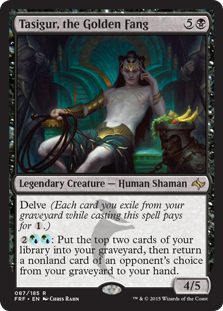 Previously used primarily for Thoughtseize, Liliana of the Veil, and multi-colored spells like Terminate, Lingering Souls, and Siege Rhino, black finally had the tools and depth to become more than just a splash. Seemingly forever plagued by a shallow, wide field of effects (Night of Souls' Betrayal/Goryo's Vengeance/Leyline of the Void?!) black traditionally finished second-best to Modern’s “better” colors. A victim of circumstance, black’s most powerful creature, Dark Confidant, swayed wildly from unbeatable to unplayable, depending on the context of the format. Phyrexian Obliterator seemed like it might elevate the color, but Path to Exile had other ideas. For a while, this imbalance went unnoticed, due in large part to the relative power of Liliana of the Veil and Thoughtseize compared to the rest of the format.
Previously used primarily for Thoughtseize, Liliana of the Veil, and multi-colored spells like Terminate, Lingering Souls, and Siege Rhino, black finally had the tools and depth to become more than just a splash. Seemingly forever plagued by a shallow, wide field of effects (Night of Souls' Betrayal/Goryo's Vengeance/Leyline of the Void?!) black traditionally finished second-best to Modern’s “better” colors. A victim of circumstance, black’s most powerful creature, Dark Confidant, swayed wildly from unbeatable to unplayable, depending on the context of the format. Phyrexian Obliterator seemed like it might elevate the color, but Path to Exile had other ideas. For a while, this imbalance went unnoticed, due in large part to the relative power of Liliana of the Veil and Thoughtseize compared to the rest of the format.
[wp_ad_camp_1]
Today, we are at a tipping point. The Event Horizon of Modern’s radical transformation is quickly approaching, and weeks from now we will look to this weekend and call it Patient Zero. Behold the new face of Modern:
"Grixis Control, Danny Jessup (22nd Place – SCG Dallas 2015)"
We’ll get to this deck in a second, but before we discuss the present and look to the future, we must first familiarize ourselves with the past.
Grixis Control 1.0
Grixis Control's origins can be traced to Grand Prix Charlotte, in the hands of a player of adequate skill named Patrick Chapin.
"Grixis Control, Patrick Chapin (9th – GP Charlotte 2015)"
Prior to GP Charlotte, Grixis Control had been slowly picking up steam on Magic Online. This deck featured the combination of Kolaghan's Command and Tasigur, the Golden Fang in a blue shell powered by Snapcaster Mage and Thought Scour. At its worst, this deck boasted incredible resiliency to discard (blue’s primary enemy) and could “only” play a 4/5 that draws cards on turn four. At its best, this deck could outgrind Jeskai Control, obliterate Affinity, and got to play Black Lotus. Pat Chapin barely missed Top 8 with this 21 land, four Cryptic Command monstrosity, but the message was clear: this deck is here to stay.
Grixis Control v1.5
Shortly after the release of Magic Origins, I wrote an article discussing the inclusion of Jace, Vryn's Prodigy in Grixis Control. Here's my list from then:
"Grixis Control, Trevor Holmes"
Alongside Thought Scour, Jace seemed like a natural fit, enabling crazy plays like turn one Thought Scour, turn two Jace, turn three flip, cast Tasigur, the Golden Fang for one mana and pass. That left you holding up Mana Leak, a 4/5 for B, and a flipped planeswalker on five loyalty. Even when our deck wasn’t operating at high velocity, casting and flipping a Jace normally assured victory, as planeswalkers with high loyalty are incredibly difficult to remove in Modern. With most decks relying on Lightning Bolt, Path to Exile, and Terminate for interaction, flipping a Jace meant we could rely on keeping him around, as spells like Hero's Downfall, Detention Sphere, and Maelstrom Pulse aren’t widely played. Abrupt Decay did see general play, but the rest of our deck was built to make Abrupt Decay actively bad as we were casting Tarmogoyf-sized threats at Tarmogoyf speeds, but with “protection from Abrupt Decay” thrown in for good measure.
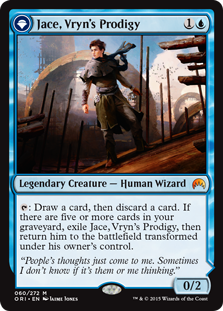 Unfortunately, Jace did die. A lot. A 0/2 for two was often awkward, especially alongside expensive delve creatures and weird spells like Cryptic Command and Remand that pushed us in different directions. Many Game 1’s saw us losing our Jace to relatively dead removal that our opponent was more than happy to cast, but even then, these interactions were more often than not favorable for us. Grixis’ best draws were its proactive ones, the draws where we cast Gurmag Angler on turn three and start beating our opponent to death. Tasigur and Gurmag Angler were already warping the metagame around themselves, forcing every deck to pack interaction that could kill an X/5, all the while making Dispel one of the best cards in the format. As the grindy control deck, forcing opponents to keep in situational removal to deal with our fast, gigantic creatures was positioning Jeskai Control could only dream about. Even if our opponents could remove our threats, they were behind on development and card advantage once we cast our Kolaghan's Command.
Unfortunately, Jace did die. A lot. A 0/2 for two was often awkward, especially alongside expensive delve creatures and weird spells like Cryptic Command and Remand that pushed us in different directions. Many Game 1’s saw us losing our Jace to relatively dead removal that our opponent was more than happy to cast, but even then, these interactions were more often than not favorable for us. Grixis’ best draws were its proactive ones, the draws where we cast Gurmag Angler on turn three and start beating our opponent to death. Tasigur and Gurmag Angler were already warping the metagame around themselves, forcing every deck to pack interaction that could kill an X/5, all the while making Dispel one of the best cards in the format. As the grindy control deck, forcing opponents to keep in situational removal to deal with our fast, gigantic creatures was positioning Jeskai Control could only dream about. Even if our opponents could remove our threats, they were behind on development and card advantage once we cast our Kolaghan's Command.
Using Jace, Vryn's Prodigy as a focal point for our strategy had some interesting effects on deckbuilding as well. Providing a pseudo-Snapcaster Mage effect, albeit at sorcery speed, Jace incentivized unique effects and de-incentivized counterspells. While the comparative merits of Terminate, Go for the Throat, and Dreadbore could be debated, when we were employing Jace it really didn’t matter, as once we had access to more of whatever effect we desired, having multiple options available provided us extra value. Somewhere around this point, the line between “control deck” and “midrange deck that abused the graveyard” started to become blurred, and sideboard cards like Rest in Peace/Relic of Progenitus were no longer a nuisance, but rather an actual disruptive element that punished our strategy. A rift began to grow among Grixis Control pilots, with this imaginary archetype line as a divider in the sand.
"Grixis Control, Michael Majors (5th - SCG Charlotte)"
Modeling his Grixis “Control” deck after Jund Midrange, almost all the way down to the manabase, Michael Majors’ struck a major blow for the Grixis Midrange team when he Top 8’d SCG Charlotte with this list. Focusing on proactive elements rather than attempting to reactively control the game with Cryptic Command, Majors sought to overpower opponents with lines like discard into Jace into Liliana into spell flashback spell. Incorporating a playset of Inquisition of Kozilek in the maindeck, with more discard in the sideboard, this deck simultaneously worked to disrupt the opponent, protect its own Jaces and Tasigurs, and even gain an edge in the mirror with both cheap disruption and an increase in threats. Rather than trying to protect its Jaces with counterspells, this list is prepared to let him die, taking advantage of positioning by forcing the opponent to react to its game, rather than the other way around. Besides, with Kolaghan's Command and Snapcaster Mage to continually re-buy creatures, who says Goodbye has to be Forever?
Grixis Control v2.0
This brings us to today.
"Grixis Control, Danny Jessup (22nd Place, SCG Dallas)"
Abandoning Spell Snare, and dropping the counterspell count from 5-7 all the way down to three, Danny Jessup is firmly in the “Grixis Midrange” camp, pushing the tap-out control strategy to the max. The playset of Inquisition of Kozilek remains, and is in my opinion one of the strongest draws to playing this variation of the archetype. Most strategies in Modern focus on executing their own gameplan and play the bare minimum of interaction to get by, meaning a timely Inquisition of Kozilek can steal a Path to Exile from G/W/x, Terminate from Jund, or Roast/Lightning Bolt from Twin. This lets our Jace, Vryn's Prodigy and Tasigur, the Golden Fang hit the field and survive to start taking over. Even when we’re looking to disrupt, and not necessarily to protect, Inquisition is excellent for snagging Eidolon of the Great Revel, Remand, Tarmogoyf, Etched Champion, and countless other spells that give us trouble. Playing discard, into Jace, into flip rebuying discard can be absolutely devastating (right Marshall Sutcliffe?) and access to both Liliana of the Veil and Kolaghan's Command to clean up can end the game in a hurry.
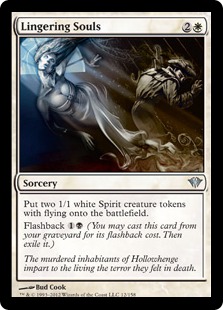 The real technology, however, comes in the form of Pia and Kiran Nalaar and Rise // Fall. Borrowing a page from Jeff Hoogland’s book, Danny Jessup correctly noticed the power of Chandra’s parents in Grixis Control, and its inclusion blurs the line between Grixis Control and Jund Midrange even further. To start, Pia and Kiran Nalaar is four power stretched across three creatures for four mana. This is already comparable to Lingering Souls, and doesn’t force us to splash white. Based purely on rate, Lingering Souls is probably slightly stronger, as the option for “3+2” is better than four up front, and the flashback does synergize well with Thought Scour.
The real technology, however, comes in the form of Pia and Kiran Nalaar and Rise // Fall. Borrowing a page from Jeff Hoogland’s book, Danny Jessup correctly noticed the power of Chandra’s parents in Grixis Control, and its inclusion blurs the line between Grixis Control and Jund Midrange even further. To start, Pia and Kiran Nalaar is four power stretched across three creatures for four mana. This is already comparable to Lingering Souls, and doesn’t force us to splash white. Based purely on rate, Lingering Souls is probably slightly stronger, as the option for “3+2” is better than four up front, and the flashback does synergize well with Thought Scour.
When we add in the Shock ability, however, the tables start to turn. Combining with Lightning Bolt to kill big threats, gunning down opposing small creatures, going to the face for a quick kill, Pia and Kiran Nalaar literally does it all. In our deck, they really seem to be a combination of Huntmaster of the Fells and Olivia Voldaren, proving the “machine-gun” ability of Olivia Voldaren with the “creature buffer” ability of Huntmaster of the Fells. Easily trading with Affinity’s board and diminishing opposing Lingering Souls, Pia and Kiran can even buy us time against an angry Tarmogoyf if we need it to. Mana requirements notwithstanding, the debate between Pia and Kiran Nalaar and Lingering Souls in our deck is close (which really speaks to the power level of the card), except for one fact: Pia and Kiran Nalaar is absolutely amazing with Kolaghan's Command and Rise // Fall!
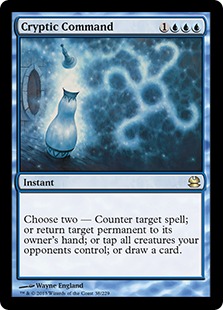 When looking at the utility of this creature in combination with these spells, our view of Pia and Kiran Nalaar really starts to change. No longer is it a slightly more expensive Lingering Souls that comes with a cool ability attached. When our deck is built with returning creatures from the graveyard in mind, Pia and Kiran Nalaar becomes a legitimate endgame we can build to, similar to Cryptic Command in Chapin’s “old” list. Alongside Tasigur, the Golden Fang and Jace, Vryn's Prodigy, Pia and Kiran Nalaar really puts our opponent in the squeeze, as no removal spell can favorably interact with all of them (sound familiar Delver of Secrets/Geist of Saint Traft/Restoration Angel?).
When looking at the utility of this creature in combination with these spells, our view of Pia and Kiran Nalaar really starts to change. No longer is it a slightly more expensive Lingering Souls that comes with a cool ability attached. When our deck is built with returning creatures from the graveyard in mind, Pia and Kiran Nalaar becomes a legitimate endgame we can build to, similar to Cryptic Command in Chapin’s “old” list. Alongside Tasigur, the Golden Fang and Jace, Vryn's Prodigy, Pia and Kiran Nalaar really puts our opponent in the squeeze, as no removal spell can favorably interact with all of them (sound familiar Delver of Secrets/Geist of Saint Traft/Restoration Angel?).
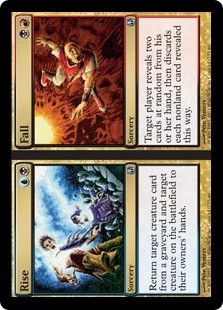 If you haven’t had the pleasure to cast Rise // Fall, you’re missing out. Sometimes, it’s Hymn to Tourach. When it’s not, it’s returning our Jace, Vryn's Prodigy in our graveyard and our Pia and Kiran Nalaar on board to our hand (for two mana), leaving a few Thopters behind for free. The inherent resiliency to discard, and the built-in ability for this deck to grind anyone out, is just off the charts. Besides the discard (and some of the removal), literally every spell in the deck either cantrips or provides some sort of two-for-one to pull us back into the game. Serum Visions sets up our draws, assuring we find action. Kolaghan's Command and Rise // Fall generate effects far beyond their mana cost. All of our threats are both great early and can take over the game single-handedly going late.
If you haven’t had the pleasure to cast Rise // Fall, you’re missing out. Sometimes, it’s Hymn to Tourach. When it’s not, it’s returning our Jace, Vryn's Prodigy in our graveyard and our Pia and Kiran Nalaar on board to our hand (for two mana), leaving a few Thopters behind for free. The inherent resiliency to discard, and the built-in ability for this deck to grind anyone out, is just off the charts. Besides the discard (and some of the removal), literally every spell in the deck either cantrips or provides some sort of two-for-one to pull us back into the game. Serum Visions sets up our draws, assuring we find action. Kolaghan's Command and Rise // Fall generate effects far beyond their mana cost. All of our threats are both great early and can take over the game single-handedly going late.
Can this deck be hated out? It doesn’t seem likely. Leyline of the Void is definitely a nuisance, as are similar effects like Rest in Peace, Relic of Progenitus, etc. Jace as just a looter isn’t the worst, and we are actually playing fewer delve creatures than we did in the past, reducing the chance that we have 4/5’s for six or 5/5’s for seven mana stuck in our hand. The fourth Snapcaster Mage was cut to fit some of this spice, and both Liliana of the Veil and Pia and Kiran Nalaar don’t care about the graveyard at all. Worst case scenario, graveyard disruption is still a solid plan against us, but we still have discard and counterspells to fight it.
Conclusion
I think we are on the verge of a large metagame shift in Modern. Grixis Control has adapted to adopt a proactive strategy that complements its strengths: controlling the game and generating value with Snapcaster Mage and Kolaghan's Command. This proactive strategy is not necessarily as potent as others in the format (as it is still a Plan B, a “means to an end”) but still powerful enough that other archetypes will be forced to adapt as a result. We’ve already seen this in the widespread adoption of removal to fight the dual roadblocks of Tasigur, the Golden Fang and Gurmag Angler, and the increase in graveyard hate to fight Grixis Controls’ inherent synergies. The shift towards discard and away from counterspells increases Grixis’ weakness to strategies that are resilient to hand disruption. For those looking to fight the evolution of this archetype, that is where I would start. What do you think? Let me know in the comments, and thanks for reading!
Trevor Holmes
The_Architect on MTGO
Twitter.com/7he4rchitect
Twitch.tv/Architect_Gaming




I think you grossly understate how crippling graveyard hate is for this deck. And unlike abzan that can just decay the rest in peace and go about its business, that grixis list you posted literally has to hit a rip with its 4-5 discard spells or else the card sticks and grixis can never get rid of it.
Good luck winning a game of modern when your deck now consists of merfolk looter, ambush viper, reach through mists, mon’s goblin raiders, and a couple of homelands calibre vanilla fatties.
Hilarious – agreed – grixis was always garbage and it still is.
I’ll third that graveyard hate is the way to beat grixis played a lot with it and against it. Jund just grinds harder and better than grixis. Lilliana is better than jace in modern.
Jund does not grind harder at all. Pia and Kiran Nalaar beats Liliana everytime, and playing PKN 3x over the course of a game is usually enough to win. Post board I bring in land destruction (2 molten rain + 1 Fulminator, which is easy to recur and flashback) as well that can just win the game on T3/4. Casting molten rain and killing a land + Lilly is pretty sweet and has happened more than once. It’s a 50/50 Matchup, and I usually come out on top when paired against jund.
RIP is tough, but white isn’t a popular color right now and I usually already have a really good matchup against the decks that would bring it in. It’s also pretty easy to get rid of with Engineered Explosives, which I run 2 of in the board. Regardless, RIP effects have been a thing that we’ve had a solid plan against for a long time.
Initially Blue Jund players were running Abbots to have a threat that generates CA without getting wrecked by RIP, then a lot of us switched to Young Pyromancer because Abbot was too slow and counterspells are good. Then PKN got printed and a few people pointed out how dumb that card actually was, and a lot of players have made the switch with no intentions of looking back.
I do get absolutely wrecked by Burn and Tron almost every time though (much like jund does). Having to keep them off Tron the whole game is tough, and the new Ulamog just ends the game basically every time. Collected Company decks can be rough, but much better post board.
Replace Tasigurs, Lavaman, and one Pia with Deceiver Exarchs, then replace Thoughtscours with Twins. Now, we have a sweet deck!
Very cool article, i love Grixis colors and woudl like to jam this deck, but i have been having much better success with Twin as the finisher. It feels more like a grindy Twin version where you go for the combo after you completely dismantled their hand and board state, but the possibility of a turn 4 “oops i win” is still there.
I agree. What do you think of Matt Ripper’s winning list at SCG St. Louis?
My latest list is close to that M.R one, but i dont like Tasigur in Twin, he feels underwhelming every time i play it, even on turn 3. And every time i activate his ability, i get something useless in a late game.
I’m doing Ripper’s list, +1 IoK, +1 Thoughtseize (i think 4 discard is where you want to be), -2 Tasigur, +1 Pia, -1 Kolghan’s Command, -1 Go for the Throat, +1 Murd Cut.
I wish i could abuse delve more, its a busted mechanic, but Tasigur in Twin… just dont like it. I usually Twin off, or win through snap/bolts or Pia beats.
Twin on Pia is so awesome, i might add all 4 Twins and have 4 Exarchs and the 2 Pia’s as “enablers”, but i havent tested that yet.
Very solid article Trevor, I still feel enchantments(void & sanctity) and decks that spread the board give this deck problems but are meta dependant. Like all modern decks you’re reliant on drawing a linear sideboard answer to combat that.
Here are some things I and others in my playgroup have tested in this shell that have given us a lot of success that i think others should consider; especially if you’re in a similar build as Jessup.
Cavern of Souls – All 12 creatures are human and this helps with color fixing as the only double spells are 1 Liliana and 2 Pia & Kiran. Between Twin, Scapeshift & the mirror making up over 13% of the online meta and having IoK & Rise // Fall, it affords you the ability to leave their counter magic and focus on their removal.
Izzet Charm – I’ve replaced remand with this card and it always over performs, early / mid its pierce or shock, mid / late its shock to possibly trade up or more card selection that goes hand in hand with the core of this deck.
Forbidden Alchemy – If DTT was legal this deck would jam it even though it competes with everything sans P&K. Alchemy is half as powerful as dig for virtually the same amount of mana, while also being easier on the base and stocks the yard. 4 < 8 but often you find an answer + ancillary piece. You can flash it back for 6B [flash back] / 3UU [snapcaster] / 2U [Jace]. I strongly encourage everyone to test it out, what is old is new again.
here is what my current MD looks like:
Creature (12)
4x Jace, Vryn's Prodigy
3x Snapcaster Mage
2x Tasigur, the Golden Fang
2x Pia and Kiran Nalaar
1x Grim Lavamancer
Spells (25)
4x Lightning Bolt
4x Serum Visions
3x Inquisition of Kozilek
2x Forbidden Alchemy
2x Kolaghan's Command
2x Mana Leak
2x Terminate
2x Thought Scour
1x Liliana of the Veil
1x Rise // Fall
1x Izzet Charm
1x Dreadbore
Land (23)
4x Polluted Delta
4x Scalding Tarn
2x Blackcleave Cliffs
2x Steam Vents
2x Creeping Tar Pit
2x Island
1x Bloodstained Mire
1x Watery Grave
1x Blood Crypt
1x Darkslick Shores
1x Mountain
1x Swamp
1x Cavern of Souls
This is the article I’ve been waiting for – Grixis Control as currently constructed is being hated out of the format, but the card pool it has access to is too potent to truly doom it to the dustbin. However, I do have a few questions:
1. While the deck has made some strides in ameliorating its dependency on the graveyard, I agree with Darcy Hartwick in that hate will still cause you some pain. Is it worth adding some sideboard cards to address living without it? Because while Engineered Explosives (which you don’t have, by the way) will let you pop Rest in Peace, this deck still has no answer to Leyline of the Void.
2. How do you answer Leyline of Sanctity turning off Liliana and your targeted discard (and the option to aim burn spells at people’s faces, for that matter)? Unlike BGx, you can’t shrug and Maelstrom Pulse.
3. Could you see this concept working somewhat similarly in Sultai? You lose Bolt (ouch), Terminate (double ouch), Kommand (triple ouch), and Pia and Kiran (not sure if this is an ouch, but probably), but you gain access to Goyf, Abrupt Decay, Maelstrom Pulse, and all of UG’s underrated (IMO) suite of tricks.
Echoing truth is the decks only answer for enchantments, then make them discard or counter…
Very nice article, Trevor.
Very much appreciated.
My main concers about the last Danny Jessup’s Grixis Control deck are those(I do not like):
1) Grim Lavamancer, 4 Jaces, Snapcasters consist a graveyard dependant deck. And it has no way of removing the hate (fe Cryptic Command, EE Sideboard)
2) I always liked 4 Snapcaster. I am unsure about this.
3) Why not Young Pyromancers?
4) Mediocre game against Burn.
5) Remand in a super fast meta. I would change this to go into another Kolaghan’s Command.
6) I would cut a Jace (down to 3) and choose one more terminate.
6) Jace’s playset Value ($$$$$) 😛
I like:
1) Great game against aggro creature based decks such as Merfolks, Affinity, Zoo etc, a department we always had problems about.
2) Pia and Kiran Nalaar.
3) Lingering Souls can be fighted in a realistic way.
What do you thing becomes the worst/best matchups like that?
Regards, gkourou.
This deck is a dog to Merfolk – how can you say it has great game against aggro? This deck is simply a worse version of the multitude of other midrange decks that you can play.
Agreed. Targeted discard and Liliana doesn’t save BGx against Merfolk, and they have Abrupt Decay. They definitely won’t save this deck.
I hesitate to say that this deck is straight-up worse than the other midrange decks, though. It’s still in the brewing phase, and I’m not sure that we’ve seen the optimal configuration yet. I definitely think this isn’t it (this deck is still very graveyard-dependent, and some of the choices make me scratch my head a bit), so we’ll see if something comes of it. It may still be hated out of the format (it still can’t deal with Leyline of Sanctity, Leyline of the Void, and Rest in Peace, all of which worries me), but we have to wait and see.
8 Snapcaster Mages assure that you always have recursive bolts terminates KK’s etc.
Against Affinity and Merfolk it is so strong play.
That costs 3-4 mana, though. Merfolk and Affinity usually don’t give you that kind of time unless you’re landing disruption every single turn and they happen to not draw cards or counter things.
And there’s the pesky problems of not having many fliers and using Islands, which means you can’t block them once they have a board state up. I can see a path to victory for this deck, but It’s not favored.
Yes, of course it is not favoured. I just think it is better than the Grixis Control chapin list. 🙂
The Marshall Sutcliffe reference is literally the best thing I’ve read here like ever!
Other than that, while I like Jaces, I think that playing less than 4 copies of snap is just wrong. I’m in the YP camp, just like George, but it’s debatable. YP version is better against linear decks, while Jaces/Mamas&Papas/RiseFall shines in grindfest. IMHO it all depends on expected metagame, but great article nonetheless
Regards,
TFSS
Seems like that deck can fight the hate with discard, counterspells and bounce effects (no, really). Not sure if it’s enough though.
While I will never leave Jeskai Control, I still really like the fact that any control deck is gaining popularity. In fact, after playing against Grixis a couple times, I actually splashed black for a Tasigur and a couple copies of Kolaghan’s Command. I like instants too much to just switch over to Grixis, but the value from getting back a Snapcaster with a Command feels amazing.
The article mentions Pia and Kiran Nalaar as an out to Lingering Souls, in effect, but what about Electrolyze? I feel like it fills the same roll in general, and is easier on the mana. Pia and Kiran are recurrable, yes, but between the mana costs to set that up and relative vulnerability to graveyard hate (as others have mentioned) they feel a little clunky to me. I suppose we’ll have to wait and see if they’re what will firmly cement the deck in the upper tiers.
Hello Trevor
Sorry for my poor english but this is not my native language.
I watched a lot of your grixis videos and most of the time, while I agree that durdling with Jace is fun, I thought that if you have play young pyro instead of Jace, you could have win the game several turns earlier.
Michael Majors came to the same conclusion (regarding the issue of closing the game) in this article http://www.starcitygames.com/article/31805_Two-Weeks-Three-Formats.html#comments and is more inclined to play some counters than discard effect. What do you think about his thoughts and his list?
Regards
N.
i watched Danny Jessup over the weekend when he played that Grixis deck. Jace, VP many times didn’t progress his board state or only gave him incremental advantage.
I feel that the best version of Grixis is the Grixis Delver version where you can play aggro or midrangey and have 4 Snapcasters to disrupt your opponent and grind them down.
Tapping out for Jace, VP is always bad from what I see. Having to protect Jace, VP after resolving him is worst. Grixis Delver was powerful for what it is because it cased only 1 cc spells during its turn and holds up mana to disrupt your opponent AND rarely cares what you did to their creatures because they can bring them back with Kolaghan’s Cmd or they have more.
Maybe Jace, VP should be cut to 2 copies in the deck and let the main engine of the deck be from the original Grixis Delver build.
My 2 cents as a grixis control player on Danny Jessups list’s individual card choices:
What I was already doing:
– Pia and Kiran: Have been running 2 for the last 3 months, and it’s been amazing every single time. Nothing to add here.
– Go for the Throat: 1 gftt instead of 1 terminate, makes all the sense even if it’s dead vs affinity u can discard it to jace or lili.
– Snapcaster: 3 of is probably the right number, as 8 flashback effects is a tad overdoing it in my experience.
– Counterspells: 2 mana leak 1 remand is the correct choice in an aggro oriented format. If every1 is playing blue counterspells and big mana “combo” decks (bloom, tron, scapeshift) then the split should be reversed imo.
What I’m not doing:
– Grim Lavamancer: interesting in the mainboard; atm it is a sideboard for me, but I can see it being flexible enough; things that worry me are the junds and twins of this world, using electrolyze, bolt, and k command better in most games than they usually would, since Jace flips rather quickly. Will most likely try this though, as I feel twin and Jund as easy enough match ups for grixis that we can suffer this loss in % to gain elsewhere.
– Rise // Fall: I cannot seem to like this card. Fall: It’s pretty good when you hymn the other grindy midrange deck (twin, jund, etc), it’s ok to take the opp last 2 burn spells if drawn in the earliest turns of the game. It fails too often to deal with the most dificcult match ups: burn and big mana decks (tron, bloom, scapeshift). Rise: More difficult to use amazingly as it requires both targets…most times I wished this was only the raise dead part as the opp is on 0 creatures or too many creatures for 2 mana bounce to matter. I feel the 3rd k command is better in most situations as it is always a 2 for 1, having more important flexibility and more board impact most of the times.
– Dreadbore: tried it, it’s ok vs lili and ok vs karn, but that doesn’t make it superior to instant speed kill your mutavault, ravine, titan, exarch that terminate provides.
– 3rd Thoughtscour: imo 1 too many without grim lavamancer, could be right with it.
Cheers,
Paul.